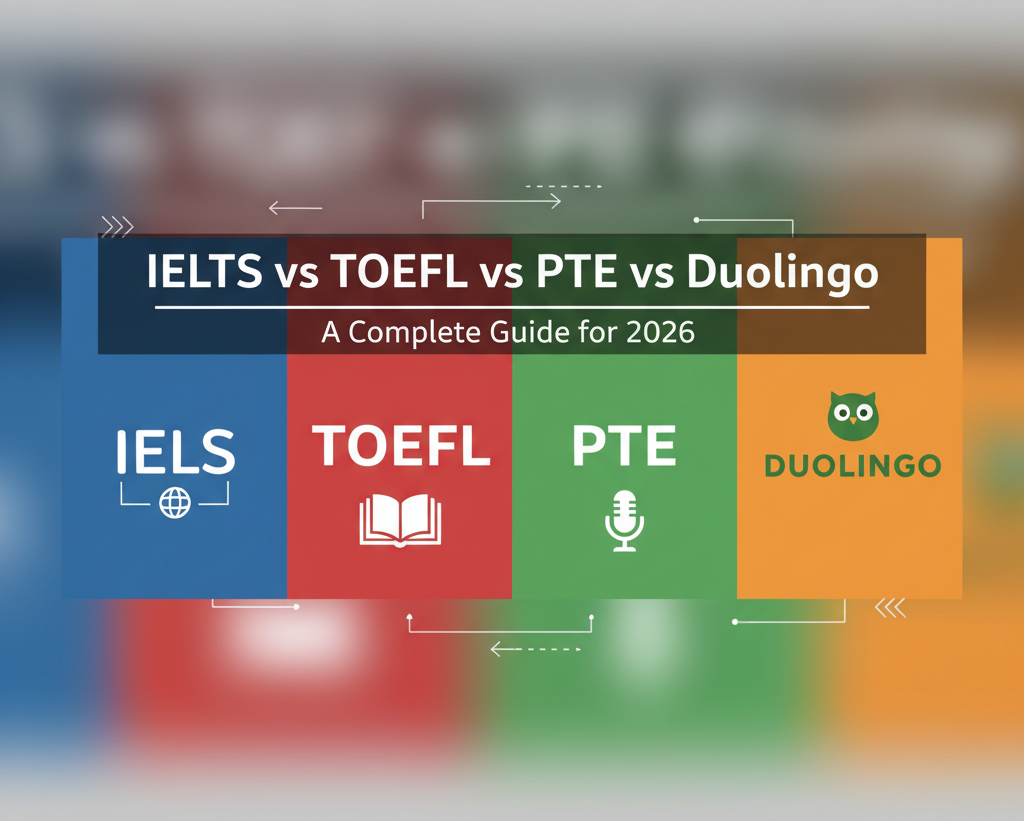Did you know that as of September 2024, the PTE accepted countries sum up to 73 countries. This computer-based PTE exam has a duration of two hours.
It is widely used for admissions, visa applications, and work permits, making it an excellent choice for students and professionals looking to study or work abroad. PTE has gained popularity as an alternative to traditional English tests like IELTS and TOEFL.

80+ Practice Questions for all sections
Instant AI Scoring
Detailed Score Improvement Report
Recorded Video Lessons
Why PTE is a Great Alternative to Other Tests
Many students and professionals choose PTE over other English tests due to its fast results, AI-based evaluation, and global acceptance. Below are the key advantages of taking the PTE exam:
1. Fast & Reliable Results
- PTE provides results within 48 hours, significantly faster than IELTS and TOEFL, which take 5-13 days.
- Ideal for applicants with urgent university deadlines or visa processing requirements.
2. Fully Computer-Based with AI Scoring
- Unlike IELTS, which has human examiners, PTE is 100% AI-scored, reducing bias in speaking and writing evaluations.
- Ensures a fair and standardised assessment for all test-takers.
3. Widely Accepted Worldwide
- Recognised by over 3,000 universities and institutions globally.
- Accepted for student visas, work visas, and permanent residency applications in PTE Accepted countries like Australia, Canada, and the UK.
4. Flexible Test Dates & Locations
- PTE offers frequent test dates throughout the year.
- Available in 350+ test centres worldwide.
5. Convenience & Integrated Format
- PTE tests multiple skills in a single question, such as listening and writing together.
- Saves time and allows for efficient test-taking.
Read More:
PTE Accepted Countries for Study, Work & Immigration
PTE is recognised in over 73 countries and accepted by 3,000+ institutions worldwide. Australia, Canada, the USA, and the UK are among the top PTE Accepted Countries for education and immigration.
PTE is becoming increasingly accepted worldwide for study, PR, and work visas, making it a strong alternative to other English proficiency exams.
Let’s take a look at the Countries Accepting PTE for PR & Work Visas:
- Australia – Officially accepted for Australian PR and work visa applications.
- New Zealand – Recognized for permanent residency (PR) and skilled migration visas.
- Canada – Not accepted for PR applications, but widely accepted for student and work visas.
- United Kingdom – Approved for some work visas, but IELTS is generally preferred.
- Germany & Other EU Nations – Accepted for student visas, but PR and work visas usually require other language tests like IELTS or TOEFL.
The PTE Accepted Countries List includes Australia, Canada, the UK, the USA, and several European nations. If you’re wondering which country accepts PTE exam, Below are some of the key countries where PTE scores are widely accepted:
PTE Accepted Universities in Australia
Australia is one of the top PTE accepted countries worldwide, with many universities accepting PTE scores for Australia as proof of English language proficiency for international students.
Here are the top universities in Australia that accept PTE scores:
| University | Minimum PTE Score for Bachelor’s & Master’s |
|---|---|
| The University of Melbourne | 58 – 65 (Bachelor’s), 65 – 79 (Master’s) |
| The University of Sydney | 58 – 64 (Bachelor’s), 68 – 74 (Master’s) |
| The University of New South Wales | 58 – 64 (Bachelor’s), 65 – 72 (Master’s) |
| The University of Queensland | 57 – 64 (Bachelor’s), 65 – 72 (Master’s) |
| Monash University | 58 – 64 (Bachelor’s), 65 – 79 (Master’s) |
| The University of Western Australia | 58 – 64 (Bachelor’s), 65 – 70 (Master’s) |
| The University of Adelaide | 50 – 58 (Bachelor’s), 60 – 65 (Master’s) |
| RMIT University | 50 – 58 (Bachelor’s), 58 – 65 (Master’s) |
| Macquarie University | 50 – 58 (Bachelor’s), 60 – 69 (Master’s) |
| The Australian National University | 58 – 64 (Bachelor’s), 65 – 79 (Master’s) |
PTE Accepted Universities in Canada
Canada is a well-known study destination for students from all around the world. Many universities in Canada accept PTE scores as proof of English language proficiency.
However, it’s important to note that the minimum score requirement may vary from university to university. Therefore, it’s highly recommended that students check with the institution before applying to ensure that they meet the requirements.
Here are the top universities in Canada that accept PTE scores:
| University | Minimum PTE Score for Bachelor’s & Master’s |
|---|---|
| University of Toronto | 60 – 65 (Bachelor’s), 68 – 73 (Master’s) |
| University of British Columbia | 58 – 65 (Bachelor’s), 65 – 72 (Master’s) |
| McGill University | 60 – 65 (Bachelor’s), 65 – 72 (Master’s) |
| University of Alberta | 55 – 60 (Bachelor’s), 60 – 68 (Master’s) |
| University of Waterloo | 58 – 63 (Bachelor’s), 63 – 70 (Master’s) |
| University of Calgary | 58 – 63 (Bachelor’s), 63 – 70 (Master’s) |
| Western University | 58 – 63 (Bachelor’s), 63 – 70 (Master’s) |
| McMaster University | 58 – 64 (Bachelor’s), 65 – 72 (Master’s) |
| University of Ottawa | 58 – 64 (Bachelor’s), 65 – 72 (Master’s) |
| Simon Fraser University | 58 – 63 (Bachelor’s), 63 – 70 (Master’s) |
PTE Accepted Universities in USA
The USA has also joined the list of PTE Academic Accepted Countries, with many PTE accepted universities in USA by many prestigious universities, making it a popular choice for international students. The test assesses the English language proficiency of non-native speakers and is an excellent option for those looking to study in US.
Here is a list of top universities in US that accept PTE scores:
| University | Minimum PTE Score for Bachelor’s & Master’s |
|---|---|
| Harvard University | 68 – 73 (Bachelor’s), 70 – 76 (Master’s) |
| Massachusetts Institute of Technology (MIT) | 65 – 70 (Bachelor’s), 70 – 76 (Master’s) |
| Yale University | 65 – 70 (Bachelor’s), 70 – 76 (Master’s) |
| Stanford University | 65 – 70 (Bachelor’s), 70 – 76 (Master’s) |
| California Institute of Technology (Caltech) | 65 – 70 (Bachelor’s), 70 – 76 (Master’s) |
| Princeton University | 65 – 70 (Bachelor’s), 70 – 76 (Master’s) |
| University of Chicago | 65 – 70 (Bachelor’s), 70 – 76 (Master’s) |
| Columbia University | 65 – 70 (Bachelor’s), 70 – 76 (Master’s) |
| Duke University | 65 – 70 (Bachelor’s), 70 – 76 (Master’s) |
| University of Pennsylvania | 65 – 70 (Bachelor’s), 70 – 76 (Master’s) |
PTE Accepted Universities in UK
Studying in UK is another popular destination for international students and is on the list of PTE accepted countries worldwide. Many Top universities accept PTE scores for UK, as proof of English language proficiency.
The minimum score requirement may vary from university to university, so it’s essential to check with the institution before applying. Unlike the US, the UK does not have a centralised system for accepting PTE scores, so students should check with each individual university.
Here is a list of top universities in UK that accept PTE scores:
| University | Minimum PTE Score for Bachelor’s & Master’s |
|---|---|
| University of Oxford | 67 – 76 (Bachelor’s), 70 – 76 (Master’s) |
| University of Cambridge | 67 – 76 (Bachelor’s), 70 – 76 (Master’s) |
| Imperial College London | 62 – 69 (Bachelor’s), 67 – 76 (Master’s) |
| University College London (UCL) | 62 – 69 (Bachelor’s), 67 – 76 (Master’s) |
| King’s College London | 62 – 69 (Bachelor’s), 67 – 76 (Master’s) |
| University of Edinburgh | 60 – 67 (Bachelor’s), 65 – 73 (Master’s) |
| University of Manchester | 60 – 67 (Bachelor’s), 65 – 73 (Master’s) |
| University of Warwick | 60 – 67 (Bachelor’s), 65 – 73 (Master’s) |
| University of Bristol | 58 – 65 (Bachelor’s), 62 – 69 (Master’s) |
| University of Glasgow | 58 – 65 (Bachelor’s), 62 – 69 (Master’s) |
PTE Accepted Universities in New Zealand
When it comes to studying in New Zealand, the choice of university can significantly impact your academic journey and prospects. As an Indian student, you’re likely aiming for institutions that not only offer excellent education but also have a global reputation.
Fortunately, New Zealand is home to several world-class universities that accept PTE scores for New Zealand as proof of English language proficiency. , each with its own unique PTE Academic score requirements
Here is a list of top universities in New Zealand that accept PTE scores:
| University | Minimum PTE Score for Bachelor’s & Master’s |
|---|---|
| University of Auckland | 50 – 58 (Bachelor’s), 58 – 65 (Master’s) |
| University of Otago | 50 – 58 (Bachelor’s), 58 – 65 (Master’s) |
| University of Canterbury | 50 – 58 (Bachelor’s), 58 – 65 (Master’s) |
| Victoria University of Wellington | 50 – 58 (Bachelor’s), 58 – 65 (Master’s) |
| University of Waikato | 50 – 58 (Bachelor’s), 58 – 65 (Master’s) |
| Massey University | 50 – 58 (Bachelor’s), 58 – 65 (Master’s) |
PTE Accepted Universities in Germany & Other European Countries
European countries like Germany and France are slowly joining the list of PTE Exam Accepted Countries. Many Top universities in Germany accept PTE scores for admission to English-taught programs, making it a viable alternative to IELTS and TOEFL.
Additionally, countries like France, Spain, the Netherlands, and Italy also recognise PTE for higher education and visa applications. With its fast results and AI-based scoring, PTE is becoming a preferred choice for students seeking opportunities in Europe.
Here is a list of universities in Germany that accept PTE scores:
| University | Minimum PTE Score for Bachelor’s & Master’s |
|---|---|
| Technical University of Munich (TUM) | 55 – 60 (Bachelor’s), 60 – 65 (Master’s) |
| Heidelberg University | 55 – 60 (Bachelor’s), 60 – 65 (Master’s) |
| Humboldt University of Berlin | 55 – 60 (Bachelor’s), 60 – 65 (Master’s) |
| RWTH Aachen University | 55 – 60 (Bachelor’s), 60 – 65 (Master’s) |
| University of Freiburg | 55 – 60 (Bachelor’s), 60 – 65 (Master’s) |
| University of Göttingen | 55 – 60 (Bachelor’s), 60 – 65 (Master’s) |
| University of Bonn | 55 – 60 (Bachelor’s), 60 – 65 (Master’s) |
PTE vs. IELTS vs. TOEFL for International Admissions
When applying to universities abroad, especially in English-speaking countries, international students must take a standardised English proficiency test. The most commonly accepted exams are PTE, IELTS, and TOEFL.
Understanding their key differences can help you choose the best test based on format, difficulty level, score requirements, and university preferences.
Country-wise Comparison of PTE vs IELTS vs TOEFL
Each country has specific requirements for English language proficiency exams based on university admissions, work permits, and immigration. Checking the latest updates on PTE Exam Accepted Countries is essential to avoid application issues. Below is a County-wise breakdown of where PTE, IELTS, and TOEFL are accepted.
United States
- PTE Acceptance: Accepted by 3,000+ institutions, including Harvard, Yale, and Columbia
- IELTS Acceptance: Widely accepted by all US universities and visa applications
- TOEFL Acceptance: Recognised by nearly all US universities, especially Ivy League schools
Canada
- PTE Acceptance: Accepted by major universities like the University of Toronto and McGill
- IELTS Acceptance: Required for student visas and universities across Canada
- TOEFL Acceptance: Recognised by Canadian institutions but less common than IELTS
United Kingdom
- PTE Acceptance: Accepted by top universities like Oxford, Cambridge, and LSE
- IELTS Acceptance: Most preferred test for UK student visas and university admissions
- TOEFL Acceptance: Accepted, but IELTS is preferred for UK visa applications
Australia
- PTE Acceptance: Accepted for both university admissions and visa applications
- IELTS Acceptance: Most widely accepted test for migration and universities
- TOEFL Acceptance: Recognised by universities but IELTS/PTE are preferred for immigration
New Zealand
- PTE Acceptance: Accepted for study visas and university admissions
- IELTS Acceptance: Required for immigration and widely accepted by universities
- TOEFL Acceptance: Recognised but less common for immigration purposes
Germany
- PTE Acceptance: Accepted by some universities for English-taught programs
- IELTS Acceptance: Preferred test for university admissions
- TOEFL Acceptance: Widely accepted for higher education
Which Test is Easier: PTE vs. IELTS vs. TOEFL?
All the tests (PTE, TOEFL, IELTS) have their own set of difficulties, but some may be easier depending on a student’s strengths. The choice of exam should ultimately depend on their preferred country, university requirements, and which test format they find more comfortable
The difficulty of these tests depends on individual preferences, exam format, and assessment criteria. Let’s take a look at the following table to understand the difference between PTE vs IELTs vs vs TOEFL
| Factors | Tests |
|---|---|
| Test Format | PTE – Fully Computer based with AI scoring IELTS – Paper-based TOEFL – Internet-based |
| Speaking Section | PTE – AI evaluates responses IELTS – Face-to-face with an examiner TOEFL – Recorded responses assessed by human scorers |
| Scoring system | PTE – 10-90 (AI-based and automated) IELTS – 1-9 band score (Human-assessed) TOEFL – 0-120 (Human and AI scoring) |
| Time Duration | PTE – 2 hours IELTS – 2 hours 45 minutes TOEFL – 3-3.5 hours |
| Result Time | PTE – Within 2-3 days IELTS – 3-5 days (Computer), 13 days (Paper) TOEFL – 4-8 days |
| Difficulty Level | PTE – Easier for those comfortable with computers IELTS – Requires strong writing and speaking skills TOEFL – More academic in nature, with complex reading and listening tasks |
| Preferred By | PTE – Students comfortable with technology and automated grading IELTS – Students who prefer human interaction in speaking TOEFL – Those comfortable with academic-style content |
Read more:
How to Improve Your PTE Score for Study & PR
Achieving a high PTE score is essential for university admissions and Permanent Residency (PR) applications in various countries. Since PTE is a computer-based test that evaluates speaking, writing, reading, and listening skills, proper preparation and strategic test-taking approaches can help you improve your score significantly.
Best Preparation Tips for Achieving Your Target Score
Let’s take a closer look at a few of the tips that we need to consider to get good scores:
- Understand the Exam Format
- Familiarise yourself with all sections of the PTE exam, including task types, time limits, and scoring criteria.
- Practice with official PTE practice test materials to get accustomed to the test structure.
- Develop Strong Speaking Skills
- Focus on fluency and pronunciation while speaking. Avoid long pauses and hesitations.
- Use PTE mock tests and AI-powered speaking evaluation tools to assess your performance.
- Master Time Management
- Each section of PTE is timed, so practice answering questions within the given time limits.
- Prioritise answering easy questions quickly to save time for more challenging ones.
- Take Full-Length Practice Tests
- Simulate real exam conditions by taking timed mock tests to build confidence.
- Review your mistakes and focus on weak areas for improvement.
- Use AI Scoring & Feedback Tools
- Utilise online PTE practice platforms with AI-based scoring to track your progress.
- Get personalised feedback on speaking, writing, and pronunciation.
Common Mistakes to Avoid in the PTE Exam
Avoiding common mistakes in the PTE exam is crucial for achieving a high score. Understanding errors related to time management, pronunciation, and response structure can help improve overall performance. Let’s understand them in detail.
- Speaking Too Fast or Too Slow
- Maintain a natural pace. Speaking too fast can lead to unclear pronunciation while speaking too slowly can impact fluency.
- Writing Lengthy & Unstructured Essays
- Stick to the word limit and follow a clear structure (introduction, body, conclusion).
- Not Managing Time Effectively
- Spending too much time on one question can affect performance in later sections. Keep track of the clock and move on if needed.
- Skipping Keywords in Listening & Reading Sections
- Missing essential keywords can lead to incorrect answers. Focus on scanning and skimming techniques to locate key information quickly.
- Not Reviewing Your Answers
- If time permits, review your responses, especially in writing and multiple-choice questions.
Conclusion
The PTE exam is an excellent option for individuals looking to demonstrate their English language proficiency for studying or working abroad. There are many PTE accepted countries in the world through which International students have the chance to apply to any country they wish to study.
At Leapscholar, we provide helpful resources for those looking to improve their English language skills or prepare for exams like IELTS, TOEFL, or PTE. We offer online courses and resources to help students achieve their goals.
Frequently Asked Questions (FAQs)
-
Q. In which countries is PTE accepted?
Ans. PTE accepted Countries include Australia, Canada, the USA, the UK, New Zealand, Germany, Ireland, Singapore, France, and more for student visas, immigration, and work purposes. Many top universities and government agencies recognise PTE as proof of English proficiency for academic and PR applications.
-
Q. Where is PTE accepted for PR?
Ans. PTE is accepted for Permanent Residency (PR) applications in Australia and New Zealand. Canada currently does not accept PTE for PR but recognises it for study visas. Australia’s Department of Home Affairs considers PTE Academic for visa and PR applications, making it a preferred choice for migration.
-
Q. Does Canada accept PTE?
Ans. Yes, Canada accepts PTE Academic for study visas and university admissions. The Immigration, Refugees and Citizenship Canada (IRCC) has approved PTE Core for visa applications. However, for PR applications, IELTS and CELPIP are currently the only accepted tests.
-
Q. Which country accepts PTE for a work visa?
Ans. Australia, New Zealand, and the UK accept PTE for work visa applications. Many employers and professional bodies in these countries recognise PTE scores for job-related immigration processes. Canada is yet to accept PTE for work visas, but it is valid for study purposes.
-
Q. Which country is best after PTE?
Ans. Australia, New Zealand, Canada, the UK, and Germany are among the best countries to study, work, or immigrate to after taking PTE. These countries offer top-ranking universities, better job prospects, and PR opportunities for international candidates with strong English proficiency
-
Q. Is PTE eligible for Europe?
Ans. Yes, PTE Academic is accepted in many European countries, including Germany, France, Spain, Ireland, and the Netherlands for university admissions. Some European universities may have specific PTE score requirements, so checking with the institution is recommended.
-
Q. Is PTE accepted in Switzerland?
Ans. Yes, some universities in Switzerland accept PTE Academic for admission to undergraduate and postgraduate programs. However, Switzerland has strict language proficiency rules, so some universities may require IELTS or TOEFL in addition to PTE for certain programs.
-
Q. Which countries accept PTE?
Ans. PTE is widely accepted in over 70 countries, including Australia, Canada, the USA, the UK, New Zealand, Germany, France, Ireland, Singapore, and UAE for study, work, and PR purposes. Many top universities and government agencies recognise PTE as a valid English proficiency test.
-
Q. Which country accepts PTE for masters?
Ans. Countries like Australia, Canada, the USA, the UK, New Zealand, Germany, and Ireland accept PTE Academic for master’s degree admissions. The required PTE score varies, but most universities ask for a score between 58 and 65 for postgraduate programs.
-
Q. Which country accepts 50 scores in PTE?
Ans. Australia, New Zealand, and some universities in Canada and the UK accept a PTE score of 50 for diploma and undergraduate courses. For master’s programs and PR, a higher score (55-65) is usually required. Some universities offer English pathway programs for lower scores.

 80+ Practice Questions for all sections
80+ Practice Questions for all sections














Have Questions? Get Guidance to reach your Dream University
Connect with India's finest counsellors and biggest study abroad community.
Get Guidance